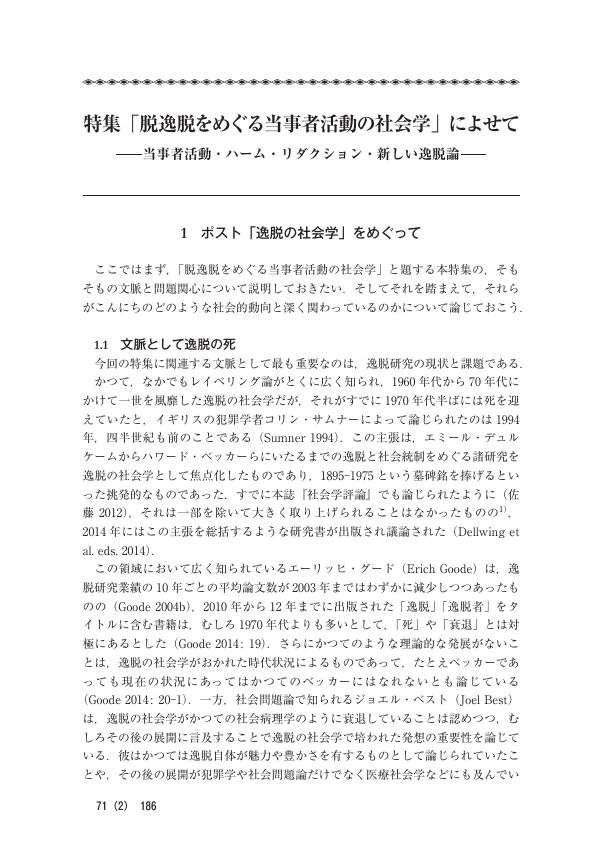24 0 0 0 OA 訪問歯科診療における感染根管処置後に発症した敗血症の1例
- 著者
- 藤井 景介 今井 謙一郎 都丸 泰寿 内藤 実 坂田 康彰 福島 洋介 小林 明男 依田 哲也
- 出版者
- 一般社団法人 日本有病者歯科医療学会
- 雑誌
- 有病者歯科医療 (ISSN:09188150)
- 巻号頁・発行日
- vol.14, no.2, pp.81-86, 2005-09-30 (Released:2011-08-11)
- 参考文献数
- 11
訪問歯科診療後, 歯性感染により敗血症を発症した症例を報告する. 患者は67歳, 男性で糖尿病, 肝硬変, 慢性腎不全があり右側頬部から頸部にかけての腫脹と激痛を主訴に当院救急部に来院した. 患者は訪問歯科診療で根管処置を受け, 同日夜より右側頬部から頸部にかけて腫脹と激痛が出現し, 全身倦怠感もみられた. われわれは右側急性下顎骨炎, 頸部蜂窩織炎と診断した. 抗菌薬投与およびドレナージ施行したが翌日より敗血症によるショック状態となった. その後, ドレナージの追加および内科的治療を行うも意識レベルがもどらず, 入院46日後, 死亡した. 死因は腎不全による尿酸の増加であった. 訪問歯科診療は近年増加する傾向にあるが, しかし, 安易な治療により重篤な感染を起こす可能性があり, 患者の既往歴および現在の全身状態の把握が必要である.
22 0 0 0 OA 〈展示品のみどころ〉薬師如来坐像(奈良 高福寺)
- 著者
- 内藤 航
- 出版者
- 奈良国立博物館
- 雑誌
- 奈良国立博物館だより
- 巻号頁・発行日
- no.118, pp.[8], 2021-07
21 0 0 0 OA 製銑技術の100年 −技術導入から先進技術への展開,そして次世代技術へ−
- 著者
- 内藤 誠章 武田 幹治 松井 良行
- 出版者
- 一般社団法人 日本鉄鋼協会
- 雑誌
- 鉄と鋼 (ISSN:00211575)
- 巻号頁・発行日
- vol.100, no.1, pp.2-30, 2014 (Released:2013-12-31)
- 参考文献数
- 218
- 被引用文献数
- 9 14
The modern blast furnace operation at integrated steel works in Japan has started in 1901 by the first blown-in of Higashida No. 1 blast furnace in Yawata Works, while a 150 years history of Japanese steel industry has dated back to the first western blast furnace built by T. Ohashi in 1857. The steel industry has been supporting the Japanese economy as a key industry which supplies base materials for social infrastructure and developments throughout the pre and post war periods.After the recovery period from the war destruction, Chiba Works of Kawasaki Steel Corp., were built and started its operation in 1953 as the first integrated steel works in Keiyo Industrial Region after the war. During the rapid growth period, many coastal steel works equipped with a large blast furnace more than 3000m3 and some of 5000m3 were built for the efficient marine transportation of raw materials and steel products. Most advanced technologies, high pressure equipment, stave cooler system and bell-less charging system etc., were introduced, improved and has risen to the top level in the world with low reducing agent ratio (RAR), energy saving and long service life of a blast furnace and coke ovens.Energy shift from oil to coal by the oil crisis, cost oriented operation design and technology were tackled and the hot metal of about 80 million tons is manufactured with 27 blast furnaces including over 5000m3 large scale blast furnaces in 2012. During this period, our industry has faced many economical and social pressures of high exchange rate of yen, oligopoly of mining market, global warming problem, and surge of iron ore and coal prices by the rapid growth of the BRICs. We have kept our competitive positions by developing advanced technologies on pulverized coal injection, extended use of low cost iron resources, recycling for environment and CO2 mitigation technologies.Prospects of ironmaking technologies for other decades are discussed by reviewing various papers published and looking back the history of ironmaking developments during the last 100 years.
21 0 0 0 国家とコミュニティ : 忍草入会闘争を通じて (岩田正美教授退職記念号)
- 著者
- 内藤 辰美 佐久間 美穂
- 出版者
- 日本女子大学
- 雑誌
- 社会福祉 (ISSN:02883058)
- 巻号頁・発行日
- vol.55, pp.201-237, 2014
20 0 0 0 OA 身体フェミニズム理論の構築ーー性暴力批判と女性の具体的なエンパワメントに向けて
本研究の成果は、歴史的に、ほとんどの社会で女性たちが担ってきたケア実践、すなわち、育児や家事、介護や看護の経験から、女性の身体性がいかに社会的に構築されてきたかを分析し、身体をめぐる脆弱性の社会的意味や女性たちの意思決定のあり方に新しい光を当てた。本研究を通じて発表された論文・著書は、これまで社会的に過小評価されるか、社会的弱者へと押しつけられがちなケア実践を再評価するために、思想的、歴史的、そして実践現場のなかで、ケア実践の意味を新たに問い返した。
19 0 0 0 OA 急性期めまいの診療フローチャート
- 著者
- 学会のあり方委員会 担当理事 : 宇佐美 真一 室伏 利久 北原 糺 委員長 : 内藤 泰 委員 : 牛尾 宗貴 城倉 健 伏木 宏彰 中村 正 関根 和教 宇野 敦彦 杉内 友理子
- 出版者
- 一般社団法人 日本めまい平衡医学会
- 雑誌
- Equilibrium Research (ISSN:03855716)
- 巻号頁・発行日
- vol.78, no.6, pp.607-610, 2019-12-31 (Released:2020-02-05)
- 参考文献数
- 4
- 被引用文献数
- 5 1
- 著者
- 内藤 光博
- 出版者
- 専修大学法学会
- 雑誌
- 専修法学論集 (ISSN:03865800)
- 巻号頁・発行日
- vol.111, pp.97-122, 2011-03-10
18 0 0 0 OA 芝地における放射性セシウムの蓄積状況と経時変化
- 著者
- 井上 智博 市川 有二郎 内藤 季和 高橋 良彦
- 出版者
- 公益社団法人 日本アイソトープ協会
- 雑誌
- RADIOISOTOPES (ISSN:00338303)
- 巻号頁・発行日
- vol.63, no.10, pp.481-488, 2014-10-15 (Released:2014-10-29)
- 参考文献数
- 9
本調査は,千葉県立柏の葉公園内の野球場の芝地において,線量率と芝・土壌中放射性セシウム濃度の経時変化について解析した。採取した芝と土壌を別々に分離して放射性セシウム濃度を定量した結果,全ての調査期間においてサッチ層(芝の根部周辺に位置する芝の刈りかすや枯れた芝の堆積物)に,その下に位置する土壌よりも放射性セシウムがより多く蓄積していることが確認された。芝の深刈りを地表面から20mm深さで均一に行い,サッチ層を取り除いたことで除染効果が得られた。
17 0 0 0 OA 千葉県柏市における土壌中放射性セシウムの深度・水平分布に係る実態調査
- 著者
- 市川 有二郎 井上 智博 内藤 季和 田中 勉 高橋 良彦
- 出版者
- 公益社団法人 日本アイソトープ協会
- 雑誌
- RADIOISOTOPES (ISSN:00338303)
- 巻号頁・発行日
- vol.64, no.8, pp.521-533, 2015-08-15 (Released:2015-08-28)
- 参考文献数
- 38
- 被引用文献数
- 1 2
降雨による土壌中の放射性セシウムの移行状況を確認するために,2013年度の梅雨期前後と台風後の千葉県柏市内の土壌を対象に調査した。本調査は,福島原発事故から約2~3年後に行われたが,地表面から深さ5cm以内に95%以上の放射性セシウムが含まれ,降雨による放射性セシウムの鉛直方向への浸透はほとんど進行していないことが示唆された。水平分布については,同一敷地内でも最大で2~3倍程度の差があることが確認された。本調査では,放射性セシウム濃度が明確な粒径依存性を示さなかったが,関東ロームの特異性が影響している可能性がある。
16 0 0 0 OA 貨幣・信用・国家 : ポスト・ケインズ派の信用貨幣論と表券主義
- 著者
- 内藤 敦之
- 出版者
- 経済理論学会
- 雑誌
- 季刊経済理論 (ISSN:18825184)
- 巻号頁・発行日
- vol.44, no.1, pp.66-76, 2007-04-20 (Released:2017-04-25)
Post Keynesian endogenous money supply theory appeared as one of the modern theory of credit money some twenty years ago. In recent years, while it keeping close relationship with French and Italian monetary circuit theory, the domain of the theory has expanded gradually. With regard to the role of government or state, the theory of endogenous money pays attention to the central bank which offers the means of settlement between commercial banks and plays the role of lender of last resort, but actually the state establishes money, and practices the control of money. In this respect Chartalism or state theory of money revive in the context of Post Keynesian in recent years. The relationship between the theory of endogenous money and Chartalism comes into question, because in the theory of endogenous money money supply is endogenous, while in Chartalism at a first glance exogenous money supply by the state is assumed. The two theories have not only a background of Post Keynesian, but also both theories have complementarities. That is, the theory of endogenous money deals the money of private level, and Chartalism argues the money of state level. However, both theories share nominalism especially in the theory of nature of money. In Chartalism the nature of money is regarded as establishment of money by the state, and Chartalistic money is a nominal one which has basically no relation to the real value, in the theory of endogenous money bank money also does not presuppose the relation to the real value of money. In this way, both theories share common ground, but there are differences. First, in the theory of nature of money the definition of money and various points are different. Second, both theories diverge in the role of the state. In the theory of endogenous money although the role of the state is generally assumed in relation to the function of central bank, the relationship between money and state, and the problem of Chartalism is not thoroughly examined. The placement of the state in Chartalism is unique and different from the theory of endogenous money. In this paper, aiming at clarifying what relationship both theories have, two points are examined. First, we compare both theories in the theory of nature of money, and we consider in what significance money in the real world is Chartalistic. Second, we investigate the role of the state, especially the function of the central bank respectively. The conclusions are three-fold. First, the theory of endogenous money and Chartalism share nominalism in the theory of nature of money. Nominalism is important in that it is a basis of the view against commodity theory of money. Second, two theories are different except nominalism of money in the theory of nature of money. In the theory of endogenous money the state plays important role in that it designate money as means of final settlement, this is the significance of Chartalism in the theory of endogenous money. Third, the role of the state in the theory of endogenous money moreover emerges as a function of central bank. The function of lender of last resort which is emphasized especially in Post Keynesian theory plays important role which maintains monetary and financial system, while in Chartalism central bank plays the role of bank of government, and does not conflict with central bank in the theory of endogenous money, but it has complementary function. Particularly both theories adopt the operation of short term interest rate as a measure of policy, which plays important role in the control of money.
16 0 0 0 突厥・ソグド人の東ローマとの交流と狼伝説
- 著者
- 内藤 みどり
- 出版者
- 早稲田大学史学会
- 雑誌
- 史觀 (ISSN:03869350)
- 巻号頁・発行日
- no.150, pp.29-50, 2004-03-25
- 著者
- 内藤 豊裕
- 出版者
- 学習院大学大学院人文科学研究科
- 雑誌
- 学習院大学人文科学論集 (ISSN:09190791)
- 巻号頁・発行日
- no.25, pp.333-365, 2016
15 0 0 0 OA スラップ訴訟と言論の自由 : 名誉毀損損害賠償裁判を利用する言論抑圧の問題性
- 著者
- 内藤 光博
- 出版者
- 専修大学今村法律研究室
- 雑誌
- 専修大学今村法律研究室報 = Senshu University Imamura Institute of Legal Studies Report (ISSN:21895716)
- 巻号頁・発行日
- vol.70, pp.1-10, 2019-01-25
15 0 0 0 OA 北海道近代史研究のための覚書
- 著者
- 内藤 隆夫
- 出版者
- 北海道大学大学院経済学研究科
- 雑誌
- 經濟學研究 (ISSN:04516265)
- 巻号頁・発行日
- vol.61, no.3, pp.21-35, 2011-12-08
本稿では北海道近代史の方法論に関する研究史の検討を通じて、今後このテーマを進めていく手がかりをつかむことを課題とした。具体的には方法論に関わる代表的論文を三つに分類し、筆者の考えをまとめた。即ちまず「開拓史観」と呼ばれる方法に対して、それへの批判の高まりが「開拓の進展」の肯定論を全否定しかねない傾向を生んだことを踏まえ、定義を修正し、批判論者が念頭に置く「開拓史観」的研究とそうでない研究を区別すべきとした。次に「辺境論」「経済学的意味における植民地論」に対して、「辺境」の本来の意味からの遊離、実証研究との対話の困難、政治・社会の問題の捨象という問題を踏まえ、「辺境」は概念ではなく本来の地理的な意味で用い、「経済学的意味における植民地」概念の安易な適用は慎むべきとした。「内国植民地論」に対しては、北海道近代史の構造把握を目指した議論であると認めた上で、「植民地」論でありながらアイヌ支配の問題を組み込めていない、「開拓史観」と同様一面的であるという問題点を指摘した。そして、今後の北海道近代史研究では開拓の進展とそこで生じた問題点との緊張関係を意識して分析を進めることが重要とした。
15 0 0 0 IR 「スター化」する声優 : 日本における「声優」とは何か?(3)
- 著者
- 内藤 豊裕
- 出版者
- 学習院大学大学院人文科学研究科
- 雑誌
- 学習院大学人文科学論集 (ISSN:09190791)
- 巻号頁・発行日
- no.26, pp.131-173, 2017
C'est à partir de la seconde moitié des années 1980 qu'au Japon le phénomène du séiyû, ou acteur de voix, a pris une forme d'autonomie, en même temps qu'une configuration médiatique originale commençait à se bâtir. A partir des années 1990, l'existence du séiyû est sortie de l'ombre. Rien n'a pourtant changé quant à la manière dont un séiyû compose son personnage par l'intermédiaire de la voix. Au début des années 1990, le séiyû s'est présenté comme un artiste. Le mot signifiait « sujet d'expression susceptible d'être diffusé sous des formes diverses, plutôt qu'il ne désignait le praticien d'un art proprement dit. En 1997, SHIINA Hekiru a donné deux jours de concert au NIPPONBUDOKAN, salle éminemment symbolique pour la musique au Japon. A l'époque, SHIINA, bien que Séiyû, ne prêtait sa voix à presque aucun personnage de dessin animé. Contrairement à aujourd'hui, il n'existait pas, à l'époque, d'environnement médiatique favorable à l'expansion de la sphère d'activité des séiyû.SHIINA a acquis une grande popularité comme vedette de la chanson mais elle est aussi un précurseur, dans un temps où le statut de vedette de la chanson était hors de la sphère du séiyû. Ses chansons ont évolué, passant des mélodies typiques de la variétés à une musique de type rock. Cette évolution s'est étendue à l'ensemble de son spectacle et a fini par la faire sortir de la catégorie des chanteuses de variété. Cette musique et ces mises en scène de concert étaient sans doute le reflet du goût et du caractère particuliers de la chanteuse. Ils lui ont permis d'acquérir la position d'artiste à l'identité reconnue et importante pour le public. Enfin le séiyû est devenu un phénomène médiatique indépendant de toute image visuelle.Depuis ce jour, la mise en scène des dessins animés s'est mise à prendre en compte la reconnaissance par le public de l'identité du séiyû. La réception du personnage de dessin animé a cessé d'entrer en contradiction avec la reconnaissance de l'identité personnelle du séiyû. Une telle situation paraît indiquer que le séiyû a atteint la dynamique propre à la vedette du cinéma telle que l'a définie Richard DYER.
14 0 0 0 OA 細胞レベルでのストレス応答 ―ストレスタンパク質の発現と機能―
- 著者
- 内藤 久士
- 出版者
- 一般社団法人日本体力医学会
- 雑誌
- 体力科学 (ISSN:0039906X)
- 巻号頁・発行日
- vol.53, no.4, pp.455-460, 2004-08-01 (Released:2010-09-30)
- 参考文献数
- 37
13 0 0 0 OA 貨幣の名目性:表券主義の貨幣理論
- 著者
- 内藤 敦之
- 出版者
- 経済理論学会
- 雑誌
- 季刊経済理論 (ISSN:18825184)
- 巻号頁・発行日
- vol.55, no.4, pp.18, 2019 (Released:2021-01-15)




